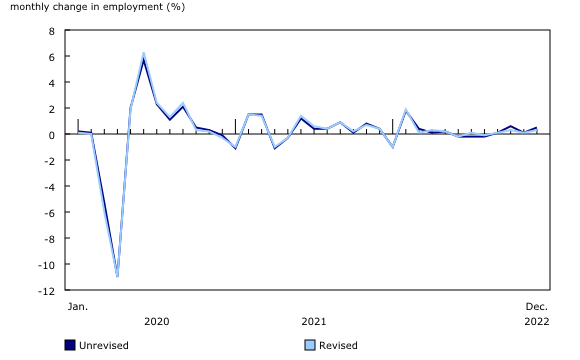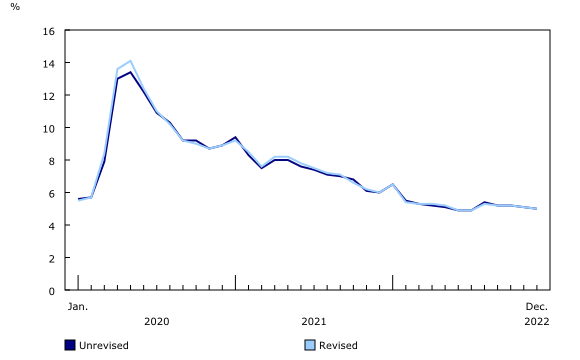Labour Force Survey: Revisions, 1987 to 2022
Released: 2023-01-30
Revised Labour Force Survey (LFS) data for the period from 1987 to 2022 are now available. The purpose of this revision is threefold:
• To align LFS data with the most recent version of the National Occupational Classification, as is done every five years;
• To introduce enhancements to the rules and parameters used in the editing and imputation of LFS data to take full advantage of data processing and information technology systems changes made in 2019; and
• To fine-tune the parameters used in the seasonal adjustment of LFS estimates, as is done every year.
These revisions ensure that survey estimates accurately reflect the Canadian labour market, while having minimal impact on the comparability of labour market indicators, such as employment, unemployment and participation rates, over time.
Future LFS releases—including the release of January 2023 data on February 10—will be aligned with these revised series.
Labour Force Survey historical revision has minimal impact on labour market trends
Over the revision period, employment levels were revised upward slightly, averaging 0.5% (+91,000) from 2006 to 2022. There was minimal difference in the month-to-month and year-over-year change in employment. The upward revision in employment was distributed proportionally across all provinces.
Outside of larger changes during the early part of the COVID-19 pandemic from March to May 2020, the unemployment rate changed by a maximum of 0.2 percentage points during the revision period. The revised national unemployment rate in December 2022 was unchanged from the unrevised rate at 5.0%.
Revised average hourly wages were 2.6% higher than unrevised wages over the period from January 2006 to December 2022. After the initial upward revision to wage estimates in 2006, trends in year-over-year wage growth among employees were equivalent on average in the revised and unrevised wage series. In December 2022, revised average hourly wages grew 4.8% (+$1.49 to $32.67) year over year, slightly less than the unrevised year-over-year increase of 5.1% (+$1.57 to $32.06).
Note to readers
More details on these revisions are available in the publication "The 2023 Revisions of the Labour Force Survey (LFS)," as part of the Improvements to the Labour Force Survey (71F0031X) series.
With today's release, the following revised data tables are available:
14-10-0017; 14-10-0023; 14-10-0026; 14-10-0027; 14-10-0063; 14-10-0064; 14-10-0065; 14-10-0066; 14-10-0287; 14-10-0288; 14-10-0289; 14-10-0291; 14-10-0292; 14-10-0310; 14-10-0320; 14-10-0342; 14-10-0355; 14-10-0373; 14-10-0380; 14-10-0383; 14-10-0408; 14-10-0409; 14-10-0410; 14-10-0411; 14-10-0412; 14-10-0415; 14-10-0416; 14-10-0417; 14-10-0418; 14-10-0419; 14-10-0420; 14-10-0421; 14-10-0422; 14-10-0423; 14-10-0424; 14-10-0425; 14-10-0426; 14-10-0427; 14-10-0430 and 14-10-0431.
New data tables have been created for detailed occupation-related series based on the National Occupational Classification 2021 labour variant and are available for 1987 onward.
The remaining tables will be released on the website according to the following schedule:
January 31, 2023
Data tables:
14-10-0019; 14-10-0020; 14-10-0021; 14-10-0022; 14-10-0028; 14-10-0029; 14-10-0030; 14-10-0031; 14-10-0032; 14-10-0033; 14-10-0034; 14-10-0035; 14-10-0036; 14-10-0037; 14-10-0042; 14-10-0043; 14-10-0044; 14-10-0045; 14-10-0048; 14-10-0049; 14-10-0050; 14-10-0051; 14-10-0054; 14-10-0055; 14-10-0057; 14-10-0058; 14-10-0059; 14-10-0060; 14-10-0067; 14-10-0068; 14-10-0069; 14-10-0070; 14-10-0071; 14-10-0072; 14-10-0075; 14-10-0076; 14-10-0077; 14-10-0078; 14-10-0081; 14-10-0082; 14-10-0083; 14-10-0084; 14-10-0085; 14-10-0086; 14-10-0087; 14-10-0088; 14-10-0089; 14-10-0104; 14-10-0117; 14-10-0118; 14-10-0121; 14-10-0122; 14-10-0123; 14-10-0124; 14-10-0125; 14-10-0126; 14-10-0127; 14-10-0128; 14-10-0129; 14-10-0130; 14-10-0132; 14-10-0133; 14-10-0134; 14-10-0286; 14-10-0327; 14-10-0359; 14-10-0363; 14-10-0364; 14-10-0365; 14-10-0366; 14-10-0367; 14-10-0376; 14-10-0377; 14-10-0378; 14-10-0379; 14-10-0384; 14-10-0385; 14-10-0387; 14-10-0388; 14-10-0391; 14-10-0392; 14-10-0393 and 14-10-0401.
February 1, 2023
Data tables:
14-10-0109; 14-10-0110; 14-10-0113; 14-10-0114; 14-10-0191; 14-10-0193; 14-10-0194; 14-10-0195; 14-10-0196; 14-10-0197; 14-10-0198; 14-10-0199; 14-10-0200; 14-10-0374; 14-10-0375; 14-10-0390; 14-10-0396; 14-10-0397; 14-10-0413; 14-10-0414; 14-10-0428; 14-10-0429 and 14-10-0437.
Next release
The January 2023 Labour Force Survey estimates will be released on February 10, 2023.
Products
The article "The 2023 Revisions of the Labour Force Survey (LFS)," which is part of Improvements to the Labour Force Survey (71F0031X) series, is now available.
Revised files for the product Labour Force Survey: Public Use Microdata File (71M0001X) for January 2006 to December 2022 are also available. Public use microdata files contain non-aggregated data for a wide variety of variables collected from the Labour Force Survey. The data have been modified to ensure that no individual or business is directly or indirectly identified. This product is for users who prefer to do their own analysis by focusing on specific subgroups in the population or by cross-classifying variables that are not in our catalogued products.
Contact information
For more information, or to enquire about the concepts, methods or data quality of this release, contact us (toll-free 1-800-263-1136; 514-283-8300; infostats@statcan.gc.ca) or Media Relations (statcan.mediahotline-ligneinfomedias.statcan@statcan.gc.ca).
- Date modified:



